Pleasantville (film)
8.2 /10 1 Votes
85% Rotten Tomatoes 71% Metacritic Genre Comedy, Drama, Fantasy Duration Country United States | 7.5/10 IMDb 4/4 Roger Ebert Featured song Rave On! Writer Gary Ross Language English | |||||||||||||||||||||||||||||||||
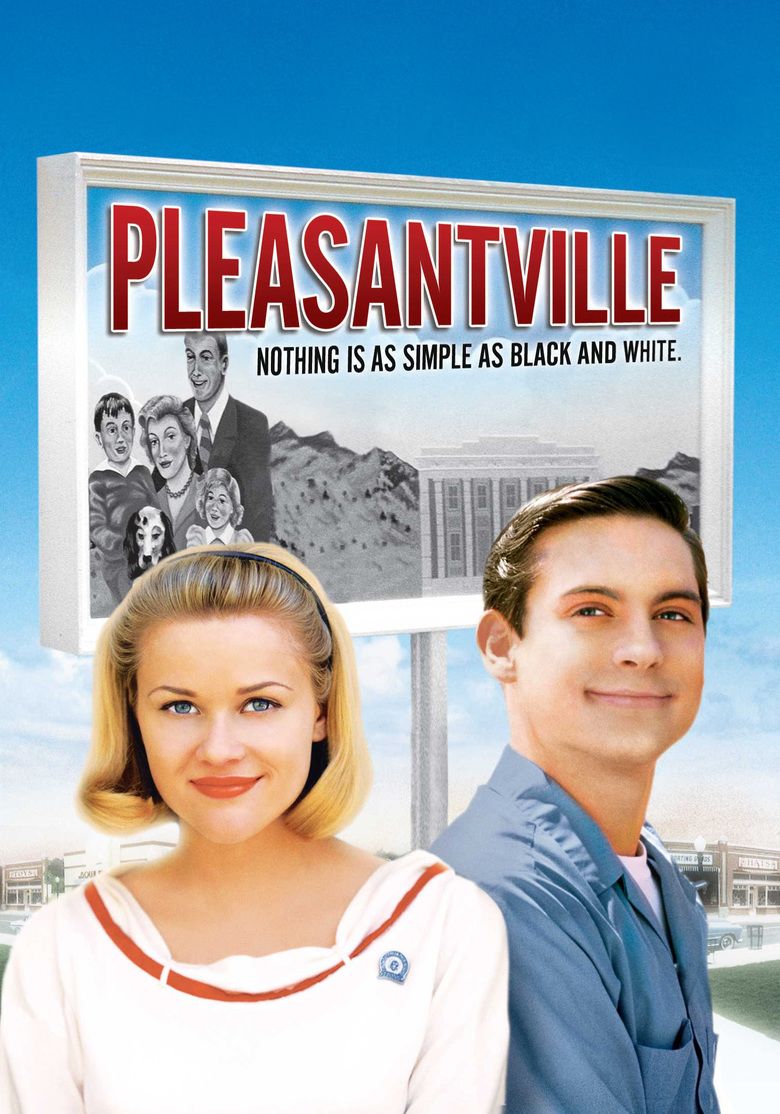 | ||||||||||||||||||||||||||||||||||
Release date October 23, 1998 (1998-10-23) Cast (David), (Jennifer), (George Parker), (Betty Parker), (Bill Johnson), (Margaret Henderson) Similar movies Blackhat , The Chronicles of Narnia: The Lion, the Witch and the Wardrobe , Scarface , Peter Pan , Mary Poppins , To Kill a Mockingbird Tagline Nothing is as simple as black and white. | ||||||||||||||||||||||||||||||||||
1998 pleasantville trailer hq
Pleasantville is a 1998 fantasy comedy-drama film written, co-produced, and directed by Gary Ross. It stars Tobey Maguire, Jeff Daniels, Joan Allen, William H. Macy, J. T. Walsh, and Reese Witherspoon, with Don Knotts, Paul Walker, and Jane Kaczmarek in supporting roles. The story centers on two siblings who wind up trapped in a 1950s TV show, set in a small Midwest town, where residents are seemingly perfect. In their attempts to fit in, the two become more aware of social issues such as racism and freedom of speech.
Contents
- 1998 pleasantville trailer hq
- Pleasantville trailer hd original
- Plot
- Cast
- Production
- Themes
- Box office
- Critical reception
- Awards and honors
- Paintings
- Books
- Soundtrack
- Pleasantville 1998 official trailer tobey maguire reese witherspoon comedy movie hd
- References
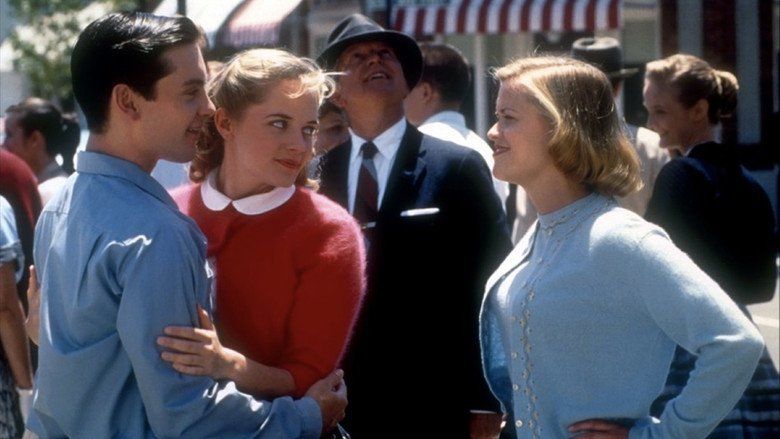
The film was released in the United States by New Line Cinema on October 23, 1998. It was a box office bomb, only acquiring about $49.8 million of a $60 million budget, but received positive reviews for its visuals, acting, and thematic elements and has gained a cult following.

The film was J. T. Walsh's final performance, and was dedicated to his memory.
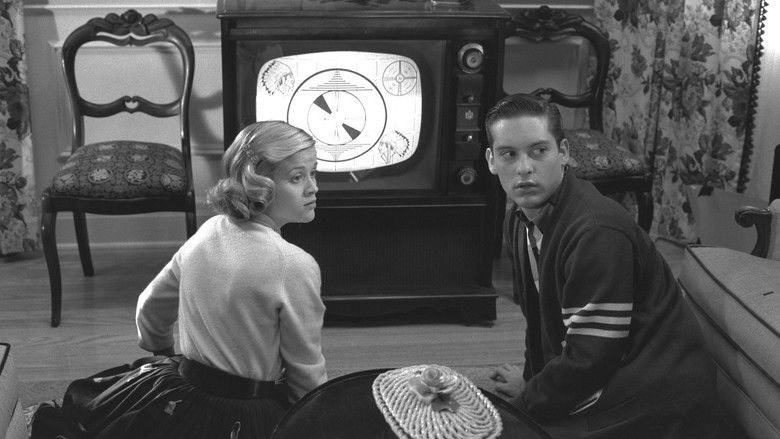
Pleasantville trailer hd original
Plot
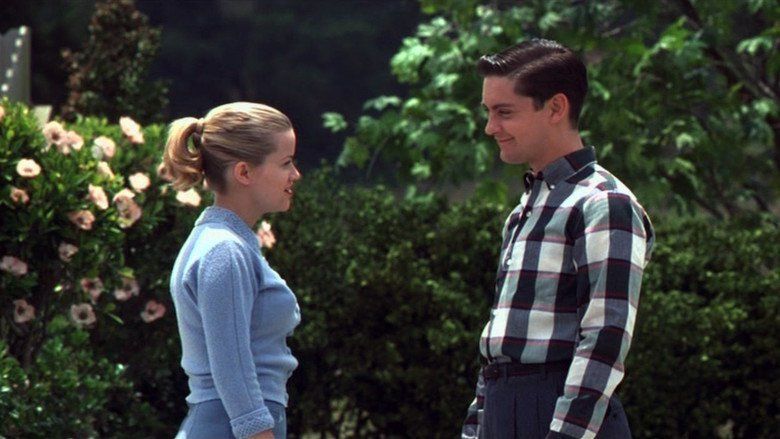
David and his twin sister Jennifer lead very different high-school social lives. Jennifer is shallow and extroverted; David is introverted and spends most of his time watching television. One evening while their mother is away, they fight over the TV. Jennifer has a date coming over and wants to watch a concert on MTV, but David wants to watch a marathon of Pleasantville, a black and white 1950s sitcom about the idyllic Parker family. During the fight, the remote control breaks, and the TV cannot be turned on manually.
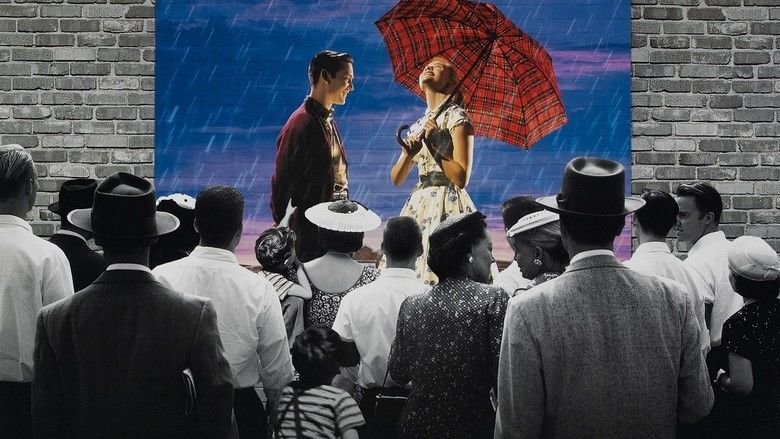
A mysterious TV repairman shows up, quizzes David about Pleasantville, then gives him a strange remote control. The repairman leaves, and David and Jennifer resume fighting. However, they are transported into the Parkers' black and white Pleasantville living room. David tries to reason with the repairman (with whom he communicates through the Parkers' television), but he succeeds only in chasing him away. David and Jennifer must now pretend they are Bud and Mary Sue Parker, the son and daughter on the show.
David and Jennifer witness the wholesome nature of the town, such as a group of firemen rescuing a cat from a tree. David tells Jennifer they must stay in character and not disrupt the lives of the town's citizens, who do not notice any difference between Bud and Mary Sue, and David and Jennifer. To keep the show's plot, Jennifer dates a boy from high school but has sex with him, a concept unknown to him and everyone else in town.
Slowly, Pleasantville begins changing from black and white to color, including flowers and the faces of people who have experienced bursts of emotion and personal transformation. David introduces Mr. Johnson, owner of the burger joint/soda fountain where Bud works, to colorful modern art via a book from the library, sparking in him an interest in painting. Johnson and Betty Parker fall in love, causing her to leave home, throwing George Parker, Bud and Mary Sue's father, into confusion. The only people who remain unchanged are the town fathers, led by the mayor, Big Bob, who sees the changes eating at the values of Pleasantville. They resolve to do something about their increasingly independent wives and rebellious children.
As the townsfolk become more colorful, a ban on "colored" people is initiated in public venues. Eventually, a riot is touched off by a nude painting of Betty (painted by Johnson) on the window of Mr. Johnson's soda fountain. The soda fountain is destroyed, books are burned, and people who are "colored" are harassed in the street. As a reaction, the town fathers announce rules preventing people from visiting the library, playing loud music, or using paint other than black, white, or gray. In protest, David and Mr. Johnson paint a colorful mural on a brick wall, depicting their world, prompting their arrest. Brought to trial in front of the town, David and Mr. Johnson defend their actions, arousing enough anger and indignation in Big Bob that the mayor becomes colored as well.
Having seen Pleasantville change irrevocably, Jennifer stays to finish her education, while David uses the remote control to return to the real world where he surprises his mother with his newfound maturity.
Cast
Production
This was the first time the majority of a new feature film was scanned, processed, and recorded digitally. The black-and-white meets color world portrayed in the movie was filmed entirely in color and selectively desaturated and contrast adjusted digitally. The work was done in Los Angeles by Cinesite utilizing a Spirit DataCine for scanning at 2K resolution. and a MegaDef Colour Correction System from Pandora International.
Cameraman Brent Hershman's death, when he fell asleep driving home after a 19-hour workday on the set of the film, resulted in a wrongful death suit, claiming that New Line Cinema, New Line Productions and Juno Pix Inc. were responsible for the death as a result of the lengthy work hours imposed on the set.
The film is dedicated to Hershman, as well as to director Ross's mother, Gail, and actor J. T. Walsh, who also died before the film's release.
Shortly before and during the film's release, an online contest was held to visit the real Pleasantville, Iowa. Over 30,000 people entered. The winner, who remained anonymous, declined the trip, and opted to receive the $10,000 cash prize instead.
Themes
Director Gary Ross stated, "This movie is about the fact that personal repression gives rise to larger political oppression...That when we're afraid of certain things in ourselves or we're afraid of change, we project those fears on to other things, and a lot of very ugly social situations can develop."
Robert Beuka says in his book SuburbiaNation, "Pleasantville is a morality tale concerning the values of contemporary suburban America by holding that social landscape up against both the Utopian and the dystopian visions of suburbia that emerged in the 1950s."
Robert McDaniel of Film & History described the town as the perfect place, "It never rains, the highs and lows rest at 72 degrees, the fire department exists only to rescue treed cats, and the basketball team never misses the hoop." However, McDaniel says, "Pleasantville is a false hope. David's journey tells him only that there is no 'right' life, no model for how things are 'supposed to be'."
Warren Epstein of The Gazette wrote, "This use of color as a metaphor in black-and-white films certainly has a rich tradition, from the over-the-rainbow land in The Wizard of Oz to the girl in the red dress who made the Holocaust real for Oskar Schindler in Schindler's List. In Pleasantville, color represents the transformation from repression to enlightenment. People—and their surroundings—change from black-and-white to color when they connect with the essence of who they really are."
Box office
Pleasantville earned $8.9 million during its opening weekend.
Critical reception
Pleasantville received positive reviews from critics. Review aggregators Rotten Tomatoes gave the film a "Certified Fresh" 84% rating from 94 reviews, an average rating of 7.6/10, with the critical consensus "Filled with lighthearted humor, timely social commentary, and dazzling visuals, Pleasantville is an artful blend of subversive satire and well-executed Hollywood formula" and Metacritic assigned a score of 71 based on 32 reviews.
Roger Ebert gave the film four out of four stars calling it "one of the best and most original films of the year". Janet Maslin wrote that its "ingenious fantasy" has "seriously belabored its once-gentle metaphor and light comic spirit." Peter M. Nichols, judging the film for its child-viewing worthiness, jokingly wrote in The New York Times that the town of Pleasantville "makes Father Knows Best look like Dallas." Joe Leydon of Variety called it "a provocative, complex and surprisingly anti-nostalgic parable wrapped in the beguiling guise of a commercial high-concept comedy." He commented that some storytelling problems emerge late in the film, but wrote that "Ross is to be commended for refusing to take the easy way out."
Entertainment Weekly wrote a mixed review: "Pleasantville is ultramodern and beautiful. But technical elegance and fine performances mask the shallowness of a story as simpleminded as the '50s TV to which it condescends; certainly it's got none of the depth, poignance, and brilliance of The Truman Show, the recent TV-is-stifling drama that immediately comes to mind." The film also received a mixed review from Christian Answers, but was criticized because "On a surface level, the message of the film appears to be “morality is black and white and pleasant, but sin is color and better,” because often through the film the Pleasantvillians become color after sin (adultery, premarital sex, physical assault, etc…). In one scene in particular, a young woman shows a brightly colored apple to young (and yet uncolored) David, encouraging him to take and eat it. Very reminiscent of the Genesis’s account of the fall of man."
Awards and honors
The film won the following accolades:
The film was nominated for the following achievements:
Other honors:
In 2008, the American Film Institute nominated this film for its Top 10 Fantasy Films list.
Paintings
David/Bud shows Bill Johnson the following paintings:
Bill Johnson's portrait of Betty Parker is in the style of an early Picasso. His later nude painting of her is inspired by Henri Matisse.
Bill and Bud defy the town elders' code of conduct by painting a mural which, with its surrealist style and inclusion of political elements, pays homage to Mexican muralism.
Books
David/Bud and Jennifer/Mary-Sue introduce the other teenagers in Pleasantville to Huckleberry Finn by Mark Twain and The Catcher in the Rye by J. D. Salinger. Mary-Sue also reads Lady Chatterley's Lover by D. H. Lawrence. All three are among the most frequently banned and challenged books according to the American Library Association.
Soundtrack
The soundtrack features music from the 1950s and 1960s such as "Be-Bop-A-Lula" by Gene Vincent, "Take Five" by The Dave Brubeck Quartet, and "At Last" by Etta James. The main score was composed by Randy Newman; he received an Oscar nomination in the original music category. A score release is also in distribution, although the suite track is only available on the standard soundtrack. Among the Pleasantville DVD "Special Features" is a music-only feature with commentary by Randy Newman.
The music video for Apple's version of "Across the Universe," directed by Paul Thomas Anderson, uses the set of the diner from the film. Allmusic rated the album two and a half stars out of five.
- "Across the Universe" - Fiona Apple – 5:07
- "Dream Girl" - Robert & Johnny – 1:57
- "Be-Bop-A-Lula" - Gene Vincent – 2:36
- "Lawdy Miss Clawdy" - Larry Williams – 2:11
- "Sixty Minute Man" - Billy Ward and His Dominoes – 2:28
- "Take Five" - The Dave Brubeck Quartet – 5:25
- "At Last" - Etta James – 3:00
- "(Let Me Be Your) Teddy Bear" - Elvis Presley – 1:47
- "Rave On!" - Buddy Holly and the Crickets – 1:49
- "Please Send Me Someone to Love" - Fiona Apple – 4:01
- "So What" - Miles Davis – 9:04
- "Suite from Pleasantville" - Randy Newman – 8:11
Pleasantville 1998 official trailer tobey maguire reese witherspoon comedy movie hd
References
Pleasantville (film) WikipediaPleasantville (film) IMDbPleasantville (film) Rotten TomatoesPleasantville (film) Roger EbertPleasantville (film) MetacriticPleasantville (film) themoviedb.org
